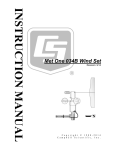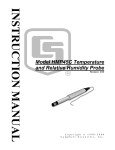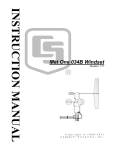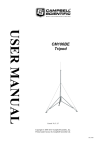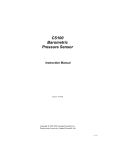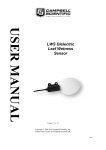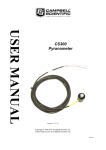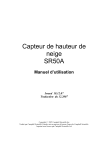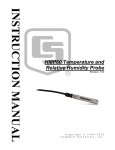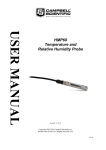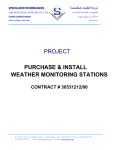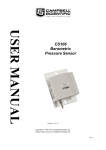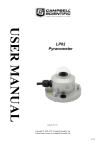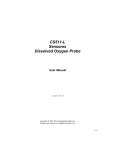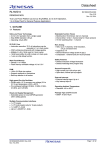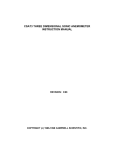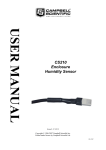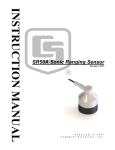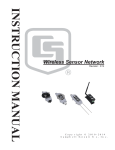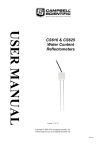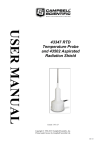Download 03002, 03101, and 03301 R.M Young Wind
Transcript
USER MANUAL 03002, 03101 and 03301 R.M. Young Wind Sentry Sensors 4 Issued: 15.6.15 Iss Copyright © 1986-2015 Campbell Scientific, Inc. Printed under licence by Campbell Scientific Ltd. CSL 830 Guarantee This equipment is guaranteed against defects in materials and workmanship. This guarantee applies for 24 months from date of delivery. We will repair or replace products which prove to be defective during the guarantee period provided they are returned to us prepaid. The guarantee will not apply to: Equipment which has been modified or altered in any way without the written permission of Campbell Scientific Batteries Any product which has been subjected to misuse, neglect, acts of God or damage in transit. Campbell Scientific will return guaranteed equipment by surface carrier prepaid. Campbell Scientific will not reimburse the claimant for costs incurred in removing and/or reinstalling equipment. This guarantee and the Company’s obligation thereunder is in lieu of all other guarantees, expressed or implied, including those of suitability and fitness for a particular purpose. Campbell Scientific is not liable for consequential damage. Please inform us before returning equipment and obtain a Repair Reference Number whether the repair is under guarantee or not. Please state the faults as clearly as possible, and if the product is out of the guarantee period it should be accompanied by a purchase order. Quotations for repairs can be given on request. It is the policy of Campbell Scientific to protect the health of its employees and provide a safe working environment, in support of this policy a “Declaration of Hazardous Material and Decontamination” form will be issued for completion. When returning equipment, the Repair Reference Number must be clearly marked on the outside of the package. Complete the “Declaration of Hazardous Material and Decontamination” form and ensure a completed copy is returned with your goods. Please note your Repair may not be processed if you do not include a copy of this form and Campbell Scientific Ltd reserves the right to return goods at the customers’ expense. Note that goods sent air freight are subject to Customs clearance fees which Campbell Scientific will charge to customers. In many cases, these charges are greater than the cost of the repair. Campbell Scientific Ltd, 80 Hathern Road, Shepshed, Loughborough, LE12 9GX, UK Tel: +44 (0) 1509 601141 Fax: +44 (0) 1509 601091 Email: [email protected] www.campbellsci.co.uk PLEASE READ FIRST About this manual Please note that this manual was originally produced by Campbell Scientific Inc. primarily for the North American market. Some spellings, weights and measures may reflect this origin. Some useful conversion factors: Area: 1 in2 (square inch) = 645 mm2 Length: Mass: 1 in. (inch) = 25.4 mm 1 ft (foot) = 304.8 mm 1 yard = 0.914 m 1 mile = 1.609 km 1 lb (pound weight) = 0.454 kg Pressure: 1 psi (lb/in2) = 68.95 mb Volume: 1 UK pint = 568.3 ml 1 UK gallon = 4.546 litres 1 US gallon = 3.785 litres 1 oz. (ounce) = 28.35 g In addition, while most of the information in the manual is correct for all countries, certain information is specific to the North American market and so may not be applicable to European users. Differences include the U.S standard external power supply details where some information (for example the AC transformer input voltage) will not be applicable for British/European use. Please note, however, that when a power supply adapter is ordered it will be suitable for use in your country. Reference to some radio transmitters, digital cell phones and aerials may also not be applicable according to your locality. Some brackets, shields and enclosure options, including wiring, are not sold as standard items in the European market; in some cases alternatives are offered. Details of the alternatives will be covered in separate manuals. Part numbers prefixed with a “#” symbol are special order parts for use with non-EU variants or for special installations. Please quote the full part number with the # when ordering. Recycling information At the end of this product’s life it should not be put in commercial or domestic refuse but sent for recycling. Any batteries contained within the product or used during the products life should be removed from the product and also be sent to an appropriate recycling facility. Campbell Scientific Ltd can advise on the recycling of the equipment and in some cases arrange collection and the correct disposal of it, although charges may apply for some items or territories. For further advice or support, please contact Campbell Scientific Ltd, or your local agent. Campbell Scientific Ltd, 80 Hathern Road, Shepshed, Loughborough, LE12 9GX, UK Tel: +44 (0) 1509 601141 Fax: +44 (0) 1509 601091 Email: [email protected] www.campbellsci.co.uk Precautions DANGER — MANY HAZARDS ARE ASSOCIATED WITH INSTALLING, USING, MAINTAINING, AND WORKING ON OR AROUND TRIPODS, TOWERS, AND ANY ATTACHMENTS TO TRIPODS AND TOWERS SUCH AS SENSORS, CROSSARMS, ENCLOSURES, ANTENNAS, ETC. FAILURE TO PROPERLY AND COMPLETELY ASSEMBLE, INSTALL, OPERATE, USE, AND MAINTAIN TRIPODS, TOWERS, AND ATTACHMENTS, AND FAILURE TO HEED WARNINGS, INCREASES THE RISK OF DEATH, ACCIDENT, SERIOUS INJURY, PROPERTY DAMAGE, AND PRODUCT FAILURE. TAKE ALL REASONABLE PRECAUTIONS TO AVOID THESE HAZARDS. CHECK WITH YOUR ORGANIZATION'S SAFETY COORDINATOR (OR POLICY) FOR PROCEDURES AND REQUIRED PROTECTIVE EQUIPMENT PRIOR TO PERFORMING ANY WORK. Use tripods, towers, and attachments to tripods and towers only for purposes for which they are designed. Do not exceed design limits. Be familiar and comply with all instructions provided in product manuals. Manuals are available at www.campbellsci.eu or by telephoning +44(0) 1509 828 888 (UK). You are responsible for conformance with governing codes and regulations, including safety regulations, and the integrity and location of structures or land to which towers, tripods, and any attachments are attached. Installation sites should be evaluated and approved by a qualified engineer. If questions or concerns arise regarding installation, use, or maintenance of tripods, towers, attachments, or electrical connections, consult with a licensed and qualified engineer or electrician. General • Prior to performing site or installation work, obtain required approvals and permits. Comply with all governing structure-height regulations, such as those of the FAA in the USA. • Use only qualified personnel for installation, use, and maintenance of tripods and towers, and any attachments to tripods and towers. The use of licensed and qualified contractors is highly recommended. • Read all applicable instructions carefully and understand procedures thoroughly before beginning work. • Wear a hardhat and eye protection, and take other appropriate safety precautions while working on or around tripods and towers. • Do not climb tripods or towers at any time, and prohibit climbing by other persons. Take reasonable precautions to secure tripod and tower sites from trespassers. • Use only manufacturer recommended parts, materials, and tools. Utility and Electrical • You can be killed or sustain serious bodily injury if the tripod, tower, or attachments you are installing, constructing, using, or maintaining, or a tool, stake, or anchor, come in contact with overhead or underground utility lines. • Maintain a distance of at least one-and-one-half times structure height, or 20 feet, or the distance required by applicable law, whichever is greater, between overhead utility lines and the structure (tripod, tower, attachments, or tools). • Prior to performing site or installation work, inform all utility companies and have all underground utilities marked. • Comply with all electrical codes. Electrical equipment and related grounding devices should be installed by a licensed and qualified electrician. Elevated Work and Weather • Exercise extreme caution when performing elevated work. • Use appropriate equipment and safety practices. • During installation and maintenance, keep tower and tripod sites clear of un-trained or non-essential personnel. Take precautions to prevent elevated tools and objects from dropping. • Do not perform any work in inclement weather, including wind, rain, snow, lightning, etc. Maintenance • Periodically (at least yearly) check for wear and damage, including corrosion, stress cracks, frayed cables, loose cable clamps, cable tightness, etc. and take necessary corrective actions. • Periodically (at least yearly) check electrical ground connections. WHILE EVERY ATTEMPT IS MADE TO EMBODY THE HIGHEST DEGREE OF SAFETY IN ALL CAMPBELL SCIENTIFIC PRODUCTS, THE CUSTOMER ASSUMES ALL RISK FROM ANY INJURY RESULTING FROM IMPROPER INSTALLATION, USE, OR MAINTENANCE OF TRIPODS, TOWERS, OR ATTACHMENTS TO TRIPODS AND TOWERS SUCH AS SENSORS, CROSSARMS, ENCLOSURES, ANTENNAS, ETC. Contents PDF viewers: These page numbers refer to the printed version of this document. Use the PDF reader bookmarks tab for links to specific sections. 1. Introduction ................................................................ 1 2. Cautionary Statements .............................................. 1 3. Initial Inspection ........................................................ 1 3.1 Ships With List .................................................................................... 2 4. Quickstart ................................................................... 2 4.1 4.2 Step 1 — Mount the Sensor ................................................................. 2 Step 2 — Use SCWin Short Cut to Program Datalogger and Generate Wiring Diagram ................................................................................ 5 5. Overview ..................................................................... 7 6. Specifications ............................................................ 8 6.1 6.2 6.3 Wind Speed (Anemometer).................................................................. 9 Wind Direction (Vane) ......................................................................... 9 Wind Sentry Assembly ........................................................................ 9 7. Installation .................................................................. 9 7.1 7.2 Siting .................................................................................................... 9 Assembly and Mounting .................................................................... 10 7.2.1 03002 Wind Sentry Set ............................................................... 10 7.2.2 03101 Anemometer ..................................................................... 10 7.2.3 03301 Vane ................................................................................. 11 7.3 Wiring ................................................................................................ 11 7.4 Programming...................................................................................... 12 7.4.1 Wind Speed ................................................................................. 13 7.4.2 Wind Direction ........................................................................... 13 7.4.3 Wind Vector Processing Instruction ........................................... 14 7.4.4 Long Lead Lengths ..................................................................... 14 8. Sensor Maintenance ................................................ 14 9. Troubleshooting ...................................................... 15 9.1 9.2 Wind Direction................................................................................... 15 Wind Speed ........................................................................................ 15 10. References ............................................................... 15 Appendix A. Importing Short Cut Code ................... A-1 A.1 Importing Short Cut Code into a Program Editor ........................... A-1 Appendix B. Example Programs .............................. B-1 i Appendix C. Setting the Wind Direction Sensor to True North .............................................................. C-1 C.1 C.2 C.3 Magnetic Declination ....................................................................... C-1 Determining True North ................................................................... C-1 Setting Up the Wind Direction Sensor on the Basic Weather StationC-2 Appendix D. Wind Direction Measurement Theory . D-1 D.1 BRHalf Instruction ...........................................................................D-1 4-1. CM200-Series Crossarm with CM220 Right Angle Mounting Bracket .............................................................................................. 3 03002 mounted to CM200-Series Crossarm with CM220 ................... 4 03002 mounted to a crossarm with pn #17953 .................................... 4 The CM216 allows an 03002 or 03101 to mount atop the mast of a CM110, CM115, or CM120 tripod .............................................. 10 03101 mounted to a crossarm via a #1049 NU-RAIL........................ 11 Magnetic Declination ....................................................................... C-1 Determining True North and Sensor Orientation ............................. C-1 Setting up the Wind Direction Sensor on the Basic Weather StationC-2 03002 and 03301 potentiometer in a half bridge circuit ..................D-1 Figures 4-2. 4-3. 7-1. 7-2. C-1. C-2. C-3. D-1. Tables 7-1. 7-2. 7-3. 7-4. B-1. 03002-L Wiring ................................................................................. 11 03101 and 03301 Wiring ................................................................... 12 Wind Speed Multiplier (With Pulse Channel Configuration Set to Low Level AC, Output “Hz”) .................................................... 13 Parameters for Wind Direction .......................................................... 14 Wiring for Example Programs using the 03002-L ........................... B-1 ii R.M. Young Wind Sentry 1. Introduction The 03002 Wind Sentry Set measures both wind speed and direction. It consists of a 3-cup anemometer and a wind vane mounted on a small crossarm. The anemometer (03101) and vane (03301) may be purchased separately to special order. NOTE 2. 3. This manual provides information only for CRBasic dataloggers. It is also compatible with the most of our retired Edlog dataloggers. For Edlog datalogger support, see an older manual at www.campbellsci.com/old-manuals or contact a Campbell Scientific application engineer for assistance. Cautionary Statements READ AND UNDERSTAND the Precautions section at the front of this manual. The 03002 is a precision instrument. Please handle it with care. If the 03002 is to be installed at heights over 6 feet, be familiar with tower safety and follow safe tower climbing procedures. Danger — Use extreme care when working near overhead electrical wires. Check for overhead wires before mounting the 03002 or before raising a tower. The black outer jacket of the cable is Santoprene® rubber. This compound was chosen for its resistance to temperature extremes, moisture, and UV degradation. However, this jacket will support combustion in air. It is rated as slow burning when tested according to U.L. 94 H.B. and will pass FMVSS302. Local fire codes may preclude its use inside buildings. Initial Inspection Upon receipt of the 03002, inspect the packaging and contents for damage. File damage claims with the shipping company. Immediately check package contents against the shipping documentation (see Section 3.1, Ships With List). Contact Campbell Scientific about any discrepancies. The model number and cable length are printed on a label at the connection end of the cable. Check this information against the shipping documents to ensure the expected product and cable length are received. 1 R.M. Young Wind Sentry 3.1 Ships With List The 03002 Wind Sentry ships with: (1) 03002 Wind Sentry including 03102 anemometer 03302 vane crossarm band clamp (pn #4919) (1) 1 inch IPS, 12 inch long, unthreaded aluminium pipe (pn 006766) (1) Allen wrench (pn #5201) The 03101 anemometer ships with: (1) 03101 anemometer (1) 3/4 inch IPS, 10 inch long, threaded aluminium pipe (pn #7623) (1) Allen wrench (pn #5201) The 03301 vane ships with: (1) 03301 vane (1) 3/4 inch IPS, 10 inch long threaded aluminium pipe (pn #7623); this assumes mounting option –P. (1) Allen wrench (pn #5201) 4. Quickstart 4.1 Step 1—Mount the Sensor This quick start is for the 03002 wind set. Refer to Section 7, Installation, if installing just the 03101 anemometer or 03301 vane. Section 7, Installation, also provides siting information. Tools required: 5/64 inch Allen wrench Allen wrench provided with sensor 1/2 inch open end wrench compass and declination angle for the site (see Appendix C) small screw driver provided with datalogger UV resistant cable ties small pair of diagonal-cutting pliers 6 inch to 10 inch torpedo level Install the 03002 using: 2 Standard 1.0-in. IPS schedule 40 pipe (pn 006766) CM220 Right-Angle Mounting Kit (Figure 4-1 and Figure 4-2), or 009285 1 x 1 inch NU-RAIL Crossover Fitting (Figure 4-3) User Manual 1. Install the cup wheel to the anemometer shaft using the Allen wrench provided with the sensor. 2. Mount the crossarm to the tripod or tower. 3. Orient the crossarm North-South, with the CM220 mount or 008285 NU-RAIL on the north end. Appendix C contains detailed information on determining True North using a compass and the magnetic declination for the site. 4. Secure the 12 in. aluminium pipe to the CM220 mount or 008285 NU-RAIL. The 006766 aluminium pipe is shipped with the 03002. 5. Place the 03002 on the pipe, and orient the sensor crossarm North-South with the vane to the North. 6. Tighten the mounting post band clamp. Final sensor orientation is done after the datalogger has been programmed to measure wind direction as described in Appendix C. 7. Route the sensor cable along the underside of the crossarm to the tripod or tower, and to the instrument enclosure. 8. Secure the cable to the crossarm and tripod or tower using cable ties. CM220 CM200-Series Crossarm Figure 4-1. CM200-Series Crossarm with CM220 Right Angle Mounting Bracket 3 R.M. Young Wind Sentry Aluminium Pipe CM220 CM200-Series Crossarm Figure 4-2. 03002 mounted to CM200-Series Crossarm with CM220 Aluminium Pipe pn #17953 NU-RAIL Cable Tie CM200-Series Crossarm Figure 4-3. 03002 mounted to a crossarm with pn #17953 4 User Manual 4.2 Step 2 — Use SCWin Short Cut to Program Datalogger and Generate Wiring Diagram The simplest method for programming the datalogger to measure the 034B is to Short Cut is an easy way to program your datalogger to measure the 014A and assign datalogger wiring terminals. The following procedure shows using Short Cut to program the 014A. 9. Install Short Cut by clicking on the install file icon. Get the install file from either www.campbellsci.com, the ResourceDVD, or find it in installations of LoggerNet, PC200W, PC400, or RTDAQ software. 10. The Short Cut installation should place a shortcut icon on the desktop of your computer. To open Short Cut, click on this icon. 11. When Short Cut opens, select New Program. 5 R.M. Young Wind Sentry 12. Select Datalogger Model and Scan Interval (default of 5 seconds is OK for most applications). Click Next. 13. Under the Available Sensors and Devices list, select the Sensors | Meteorological | Wind Speed & Direction folder. Select 03002 Wind Speed & Direction Sensor. Click to move the selection to the Selected device window. The wind speed defaults to metres/second. This can be changed by clicking the Wind Speed box and selecting one of the other options. 6 User Manual 14. After selecting the sensor, click at the left of the screen on Wiring Diagram to see how the sensor is to be wired to the datalogger. The wiring diagram can be printed out now or after more sensors are added. 15. Select any other sensors you have, then finish the remaining Short Cut steps to complete the program. The remaining steps are outlined in Short Cut Help, which is accessed by clicking on Help | Contents | Programming Steps. 16. If LoggerNet, PC400, RTDAQ, or PC200W is running on your PC, and the PC to datalogger connection is active, you can click Finish in Short Cut and you will be prompted to send the program just created to the datalogger. 17. If the sensor is connected to the datalogger, as shown in the wiring diagram in step 6, check the output of the sensor in the datalogger support software data display to make sure it is making reasonable measurements. 5. Overview The 03002 Wind Sentry Set is used to measure horizontal wind speed and direction. Wind speed is measured with a three cup anemometer. Rotation of the cup wheel produces an ac sine wave voltage with frequency proportional to wind speed. This is a special version of the 03102 built for Campbell Scientific by R.M. Young that has shielded bearings rather than sealed bearings. The shielded bearings provide a lower starting threshold than sealed bearings. Vane position is transmitted by a 10-k potentiometer. With a precision excitation voltage applied, the output voltage is proportional to wind direction. The 03101 Anemometer and 03301 Vane can be ordered as separate sensors, which are also covered in this manual. These two sensors combined differ from the 03002 only by the absence of a junction box. The R.M. Young Instruction Manual includes additional information on the operating principles, installation, and maintenance of the sensor. 7 R.M. Young Wind Sentry NOTE CAUTION Do not exceed 304 m (1,000 feet) of cable. Do not use long lead lengths in electrically noisy environments. The 03002’s cable can terminate in: 6. Connector that attaches to a prewired enclosure (option –PW). Refer to www.campbellsci.com/prewired-enclosures for more information. Connector that attaches to a CWS900 Wireless Sensor Interface (option – CWS). The CWS900 allows the 03002 to be used in a wireless sensor network. Refer to www.campbellsci.com/cws900 for more information. Specifications Features: Designed for continuous, long term, unattended operation in adverse conditions Small size, simplicity, and rugged construction provide a quality instrument for a modest price Ideal for wind profile studies Compatible with the LLAC4 4-channel Low Level AC Conversion Module, which increases the number of anemometers one datalogger can measure Campbell Scientific version uses shielded bearings, which lowers the anemometer’s starting threshold Compatible with Campbell Scientific CRBasic dataloggers: CR6, CR200(X) series, CR800 series, CR1000, CR3000, CR5000, and CR9000X. 8 User Manual 6.1 Wind Speed (Anemometer) Range: Sensor: Accuracy: Turning Factor: Distance Constant (63% recovery): Threshold: Transducer: Output: Output Frequency: Cup Wheel Diameter: Weight: 6.2 Transducer: Transducer Excitation Requirement: Output: Vane Length: Vane Weight: 360° mechanical, 352° electrical (8° open) Balanced vane, 16 cm turning radius ±5° 0.2 0.5 m (1.6 ft) 0.8 m s–1 (1.8 mph) at 10° displacement (1.8 m s–1 (4 mph) at 5° displacement) Precision conductive plastic potentiometer; 10 k resistance; 1.0% linearity; life expectancy 50 million revolutions Rated 1 W at 40 °C, 0 W at 125 °C Regulated dc voltage, 15 Vdc max Analogue dc voltage proportional to wind direction angle with regulated excitation voltage supplied by the datalogger 22 cm (8.7 in) 170 g (6 oz) Wind Sentry Assembly Operating Temperature: Overall Height: Crossarm Length: Mounting Diameter: 7. 2.3 m (7.5 ft) 0.5 m s–1 (1.1 mph) Stationary coil, 1300 ohm nominal resistance AC sine wave signal induced by rotating magnet on cup wheel shaft 100 mV peak-to-peak at 60 rpm; 6 V peak-to-peak at 3600 rpm 1 cycle per cup wheel revolution; 0.75 m s–1 per Hz 12 cm (4.7 in) 113 g (4 oz) Wind Direction (Vane) Range: Sensor: Accuracy: Damping Ratio: Delay Distance (50% recovery): Threshold: 6.3 0 to 50 m s–1 (112 mph), gust survival 60 m s–1 (134 mph) 12 cm diameter cup wheel assembly, 40 mm diameter hemispherical cups ±0.5 m s–1 (1.1 mph) 75 cm (2.5 ft) –50 to 50 °C assuming non-riming conditions 32 cm (12.6 in) 40 cm (15.7 in) between instruments (centre-to-centre) 34 mm (1.34 in), mounts on standard 1 in. IPS pipe Installation If you are programming your datalogger with Short Cut, skip Section 7.3, Wiring, and Section 7.4, Programming. Short Cut does this work for you. See Section 4, Quickstart, for a Short Cut tutorial. 7.1 Siting Locate wind sensors away from obstructions (e.g., trees and buildings). As a general rule of thumb, there should be a horizontal distance of at least ten times the height of the obstruction between the wind set and the obstruction. If it is necessary 9 R.M. Young Wind Sentry to mount the sensors on the roof of a building, the height of the sensors above the roof, should be at least 1.5 times the height of the building. See Section 10, References, for a list of references that discuss siting wind speed and direction sensors. 7.2 Assembly and Mounting 7.2.1 03002 Wind Sentry Set The 03002 mounts to a standard 1.0 in. IPS schedule 40 pipe (1.34 in. O.D.). A 12” long mounting pipe ships with the 03002. The mounting pipe typically fastens to a CM200-series crossarm via the CM220 mount or 17953 NU-RAIL fitting. Section 4, Quickstart, describes mounting the 03002 using a CM220 mount or a 17953 NURAIL fitting. The 03002 can also be mounted at the top of a CM106B, CM110, CM115, or CM120 tripod with the CM216 (see Figure 7-1). The CM216 extends 10 cm (4 in) above the mast of the tripod. Fits in Mast Figure 7-1. The CM216 allows an 03002 or 03101 to mount atop the mast of a CM110, CM115, or CM120 tripod 7.2.2 03101 Anemometer The 03101 is mounted to a tripod or tower using the tools listed in the beginning of Section 4.1, Step 1—Mount the Sensor. 10 1. Install the cup wheel to the anemometer shaft using the Allen wrench provided with the sensor. 2. Mount the crossarm to the tripod or tower, or mount the CM216 atop a CM106B, CM110, CM115, or CM120 tripod. 3. Secure the 3/4 inch IPS, 10 inch long, threaded aluminium pipe (pn #7623) to the CM220 mount (see Figure 4-1 in Quickstart), 1049 NU-RAIL (Figure 7-2), or CM216 (see Figure 7-1). 4. Place the 03101 on the pipe. 5. Route the sensor cable to the instrument enclosure. If using a crossarm the cable should be routed along the underside of the crossarm. 6. Secure the cable to the crossarm and tripod or tower using cable ties. User Manual Cable Tie Crossarm #1049 NU-RAIL Fitting Figure 7-2. 03101 mounted to a crossarm via a #1049 NU-RAIL 7.2.3 03301 Vane The 03301 wind vane has three mounting options 7.3 No Mounting (option –NM) is used when the 03301 will be replacing an existing 03301 within a Wind Sentry Set. Pipe Offset Mount (option –P) is used when the 03301 will be deployed on its own next to an anemometer that already has its own mount. With this option, the 03301 mounts to a crossarm using the CM220 mount or #1049 NU-RAIL fitting. 03101 Conversion Kit (option –SM) is used when the 03301 will be mounted next to a previously purchased 03101 Anemometer (Wind Sentry Anemometer). This conversion kit includes the crossarm and other hardware to mount both sensors to a common crossarm as if they had been purchased originally as a complete Wind Sentry Set. Wiring Connections to CRBasic dataloggers are given in Table 7-1 and Table 7-2. To wire an Edlog datalogger, see an older manual at www.campbellsci.com/old-manuals, or contact a Campbell Scientific application engineer for assistance. Table 7-1. 03002-L Wiring Colour Description CR6 CR800 CR5000 CR3000 CR1000 Red Wind Spd. Signal Pulse Black Wind Spd. Reference Clear Shield CR200(X) P_LL 11 R.M. Young Wind Sentry White Wind Dir. Reference Green Wind Dir. Signal SE Analogue SE Analogue Blue Wind Dir. Excitation Excitation Excitation Table 7-2. 03101 and 03301 Wiring Colour Description CR6 CR800 CR5000 CR3000 CR1000 Black Wind Spd. Signal Pulse P_LL White Wind Spd. Reference Clear Wind Spd. Shield Red Wind Dir. Signal SE Analogue SE Analogue Black Wind Dir. Excitation Excitation Excitation White Wind Dir. Reference Clear Wind Dir. Shield Wind Speed 03101 7.4 CR200(X) Wind Direction 03301 Programming Short Cut is the best source for up-to-date datalogger programming code. Programming code is needed, when creating a program for a new datalogger installation. when adding sensors to an existing datalogger program. If your data acquisition requirements are simple and you are connecting the sensor to a pulse port, you can probably create and maintain a datalogger program exclusively with Short Cut. If your data acquisition needs are more complex, the 12 User Manual files that Short Cut creates are a great source for programming code to start a new program or add to an existing custom program. NOTE Short Cut cannot edit programs after they are imported and edited in CRBasic Editor. A Short Cut tutorial is available in Section 0, Step 2 — Use SCWin to Program Datalogger and Generate Wiring Diagram. If you wish to import Short Cut code into CRBasic Editor to create or add to a customized program, follow the procedure in Appendix A.1, Importing Short Cut Code into a Program Editor. Programming basics for CRBasic dataloggers are provided in the following sections. Complete program examples for select CRBasic dataloggers can be found in Appendix B, Example Programs. Programming basics and programming examples for Edlog dataloggers are provided at www.campbellsci.com/old-manuals. 7.4.1 Wind Speed Wind speed is measured with the Pulse Count instruction (PulseCount() in CRBasic. Use the low level AC configuration. The expression for wind speed (U) is: U = MX + B where M = multiplier X = number of pulses per second (Hertz) B = offset TABLE 7-3 lists the multipliers (M) and offsets (Off) to obtain metres/second or miles/hour when the Pulse Count instruction is configured to output the result in hertz. Table 7-3. Wind Speed Multiplier (With Pulse Channel Configuration Set to Low Level AC, Output “Hz”) Model Metres/Second Miles/Hour 03002 / 03101 M = 0.750 Off = 0.2 M = 1.677 Off = 0.4 *When the pulse channel configuration is set to Low Level AC, output “counts”, the multiplier above is divided by the execution interval in seconds. 7.4.2 Wind Direction The wind vane is coupled to a 10 k potentiometer, which has an 8 degree electrical dead band between 352 and 360 degrees. The CR200(X) dataloggers use the ExDelSE() instruction to measure wind direction. All other CRBasic dataloggers use the BRHalf() instruction. Excitation voltages, range codes, and multipliers for Campbell Scientific dataloggers are listed in Table 7-4. Appendix D has additional information on the BRHalf() measurement instructions. 13 R.M. Young Wind Sentry Table 7-4. Parameters for Wind Direction CR200(X) CR800 CR1000 CR6 CR5000 CR3000 Measurement Range 2500 mV, slow 2500 mV,60 Hz, reverse excitation 5000 mV,60 Hz, reverse excitation Excitation Voltage 2500 mV 2500 mV 5000 mV Multiplier 0.1408 352 352 Offset 0 0 0 7.4.3 Wind Vector Processing Instruction The Wind Vector output instruction is used to process and store mean wind speed, unit vector mean wind direction, and standard deviation of the wind direction (optional) from the measured wind speed and direction values. 7.4.4 Long Lead Lengths When sensor lead length exceeds 100 feet, the settling time allowed for the measurement of the vane should be increased to 20 milliseconds. For the CR200(X), increase the Settling Time parameter of the ExDelSE() instruction to 20 milliseconds (20,000 microseconds). For the other CRBasic dataloggers, increase the Settling Time parameter of the BRHalf() instruction to 20 milliseconds (20,000 microseconds). CAUTION 8. The 60 Hz rejection option cannot be used with the Half Bridge instruction, when the delay is not zero. Do not use long lead lengths in electrically noisy environments. Sensor Maintenance Every month do a visual/audio inspection of the anemometer at low wind speeds. Verify that the cup assembly and wind vane rotate freely. Inspect the sensor for physical damage. Replace the anemometer bearings when they become noisy, or the wind speed threshold increases above an acceptable level. The condition of the bearings can be checked with a paper clip as described in the R.M. Young manual The potentiometer has a life expectancy of fifty million revolutions. As it becomes worn, the element can produce noisy signals or become nonlinear. Replace the potentiometer when the noise or nonlinearity becomes unacceptable. Refer to the Assistance page at the beginning of this document for the procedure of returning the sensor to Campbell Scientific for wind vane and bearing replacement. 14 User Manual 9. Troubleshooting 9.1 Wind Direction Symptom: NAN, –9999, or no change in direction 1. Check that the sensor is wired to the excitation and single-ended channel specified by the measurement instruction. 2. Verify that the excitation voltage and range code are correct for the datalogger type. 3. Disconnect the sensor from the datalogger and use an ohm meter to check the potentiometer. Resistance should be about 10 k between the black and white wires. The resistance between either the black/red or white/red wires for the 03301 and blue/red or white/red for the 03002 should vary from 1 k to 11 k depending on vane position. Resistance when the vane is in the 8 degree dead band should be about 1 M. Symptom: Incorrect wind direction 9.2 1. Verify that the excitation voltage, range code, multiplier, and offset parameters are correct for the datalogger type. 2. Check orientation of sensor as described in Section 4.1, Step 1 — Mount the Sensor. Wind Speed Symptom: No wind speed 1. Check that the sensor is wired to the pulse channel specified by the pulse count instruction. 2. Disconnect the sensor from the datalogger and use an ohm meter to check the coil. The resistance between the white and black wires for the 03101 and black and red wires for the 03002 should be a nominal 1300 ohms. Infinite resistance indicates an open coil; low resistance indicates a shorted coil. 3. Verify that the configuration code, and multiplier and offset parameters for the pulse count instruction are correct for the datalogger type. 10. References The following references give detailed information on siting wind speed and wind direction sensors. EPA, 1989: Quality Assurance Handbook for Air Pollution Measurements System, Office of Research and Development, Research Triangle Park, NC, 27711. EPA, 1987: On-Site Meteorological Program Guidance for Regulatory Modelling Applications, EPA-450/4-87-013, Office of Air Quality Planning and Standards, Research Triangle Park, NC 27711. The State Climatologist, 1985: Publication of the American Association of State Climatologists: Height and Exposure Standards, for Sensors on Automated Weather Stations, vol. 9, No. 4. 15 R.M. Young Wind Sentry WMO, 1983: Guide to Meteorological Instruments and Methods of Observation, World Meteorological Organization, No. 8, 5th edition, Geneva, Switzerland. 16 Appendix A. Importing Short Cut Code This tutorial shows: How to import a Short Cut program into a program editor for additional refinement. How to import a wiring diagram from Short Cut into the comments of a custom program. A.1 Importing Short Cut Code into a Program Editor Short Cut creates files that can be imported into CRBasic Editor program editor. These files normally reside in the C:\campbellsci\SCWin folder and have the following extensions: .DEF (wiring and memory usage information) .CR6 (CR6 datalogger code) .CR2 (CR200(X) datalogger code) .CR1 (CR1000 datalogger code) .CR8 (CR800 datalogger code) .CR3 (CR3000 datalogger code) .CR9 (CR9000(X) datalogger code) Use the following procedure to import Short Cut code into CRBasic Editor (CR6, CR200(X), CR1000, CR800, CR3000, CR5000 CR9000(X) dataloggers). NOTE 1. Create the Short Cut program following the procedure in Section 4, Quickstart. Finish the program and exit Short Cut. Make note of the file name used when saving the Short Cut program. 2. Open CRBasic Editor. 3. Click File | Open. Assuming the default paths were used when Short Cut was installed, navigate to C:\CampbellSci\SCWin folder. The file of interest has a “.CR6”, “.CR2”, “.CR1”, “.CR8”, “.CR3”, “.CR9”, or “.CR5” extension, for CR6, CR200(X), CR1000, CR800, CR3000, CR9000(X), or CR5000 dataloggers, respectively. Select the file and click Open. 4. Immediately save the file in a folder different from \Campbellsci\SCWin, or save the file with a different file name. Once the file is edited with CRBasic Editor, Short Cut can no longer be used to edit the datalogger program. Change the name of the program file or move it, or Short Cut may overwrite it next time it is used. 5. The program can now be edited, saved, and sent to the datalogger. 6. Import wiring information to the program by opening the associated .DEF file. Copy and paste the section beginning with heading “-Wiring for CRXXX–” into the CRBasic program, usually at the head of the file. After pasting, edit the information such that a ' character (single quotation mark) begins each line. This character instructs the datalogger compiler to ignore the line when compiling the datalogger code. A-1 Appendix A. Importing Short Cut Code A-2 Appendix B. Example Programs This CR1000 program measures the 03002 every 5 seconds, and store mean wind speed, unit vector mean direction, and standard deviation of the direction every 60 minutes. Wiring for the examples is given in Table B-1. Table B-1. Wiring for Example Programs Colour Wire Label CR1000 CR6 CR200X P1 U4 P_LL Red WS Signal Black WS Reference Clear Shield Green WD Signal SE 1 U2 SE 1 Blue WD Volt Excit VX 1 U1 VX1 White WD Reference B.1 Example CR1000 Program 'CR1000 'Declare Variables and Units Public Batt_Volt Public WS_ms Public WindDir Units Batt_Volt=Volts Units WS_ms=meters/second Units WindDir=Degrees 'Define Data Tables DataTable(Hour,True,-1) DataInterval(0,60,Min,10) WindVector (1,WS_ms,WindDir,FP2,False,0,0,0) FieldNames("WS_ms_S_WVT,WindDir_D1_WVT,WindDir_SD1_WVT") EndTable 'Main Program BeginProg Scan(5,Sec,1,0) 'Default Datalogger Battery Voltage measurement Batt_Volt: Battery(Batt_Volt) '03002 or 03101 RM Young Wind Sentry Wind Speed Sensor measurement 'WS_ms: PulseCount(WS_ms,1,1,1,1,0.75,0.2) If WS_ms<0.21 Then WS_ms=0 '03002 or 03301 RM Young Wind Sentry Wind Direction Sensor 'measurement - WindDir: BrHalf(WindDir,1,mV2500,1,1,1,2500,True,20000,_60Hz,352,0) 'Use mV5000 range and 5000 mV excitation for CR3000 and CR5000 'dataloggers. If WindDir>=360 OR WindDir<0 Then WindDir=0 'Call Data Tables and Store Data CallTable(Hour) NextScan EndProg B-1 Appendix B. Example Programs B.2 Example CR200(X) Program 'CR200/CR200X Series 'Declare Variables and Units Public BattV Public WS_ms Public WindDir Units BattV=Volts Units WS_ms=meters/second Units WindDir=degrees 'Define Data Tables DataTable(Hour,True,-1) DataInterval(0,60,Min) WindVector(WS_ms,WindDir,False,0,0) FieldNames("WS_ms_S_WVT,WindDir_D1_WVT,WindDir_SD1_WVT") EndTable 'Main Program BeginProg 'Main Scan Scan(5,Sec) 'Default Datalogger Battery Voltage measurement 'BattV' Battery(BattV) '03002 Wind Speed & Direction Sensor measurements 'WS_ms' and 'WindDir' 'WS_ms PulseCount(WS_ms,P_LL,1,1,0.75,0.2) If WS_ms<0.21 Then WS_ms=0 'WindDir ExDelSE(WindDir,1,1,1,mV2500,20000,0.1408,0) If WindDir>=360 OR WindDir<0 Then WindDir=0 'Call Data Tables and Store Data CallTable Hour NextScan EndProg B-2 R.M. Young Wind Sentry B.3 Example CR6 Program 'CR6 Series 'Declare Variables and Units Public BattV Public PTemp_C Public WS_ms Public WindDir Units Units Units Units BattV=Volts PTemp_C=Deg C WS_ms=meters/second WindDir=degrees 'Define Data Tables DataTable(Hour,True,-1) DataInterval(0,60,Min,10) WindVector(1,WS_ms,WindDir,FP2,False,0,0,0) FieldNames("WS_ms_S_WVT,WindDir_D1_WVT,WindDir_SD1_WVT") EndTable 'Main Program BeginProg 'Main Scan Scan(5,Sec,1,0) 'Default Datalogger Battery Voltage measurement 'BattV' Battery(BattV) 'Default Wiring Panel Temperature measurement 'PTemp_C' PanelTemp(PTemp_C,60) '03002 Wind Speed & Direction Sensor measurements 'WS_ms' and 'WindDir' 'WS_ms PulseCount(WS_ms,1,U4,5,1,0.75,0.2) If WS_ms<0.21 Then WS_ms=0 'WindDir BrHalf(WindDir,1,mV1000,U2,U1,1,1000,True,20000,60,352,0) If WindDir>=360 OR WindDir<0 Then WindDir=0 'Call Data Tables and Store Data CallTable Hour NextScan EndProg B-3 Appendix C. Setting the Wind Direction Sensor to True North To get optimum wind direction data from your weather station, it is recommended that you set up your wind direction sensor with reference to true north (rather than magnetic north). This Appendix provides advice on how to achieve this. C.1 Magnetic Declination Magnetic declination is sometimes referred to as the magnetic variation or the magnetic compass correction. It is the angle formed between true north and the projection of the magnetic field vector on the horizontal plane. Magnetic declination varies according to geographical location. In the UK, for instance, it changes by over eight degrees from the most Easterly to the most Westerly points. Also, the magnetic pole tends to wander or drift, so its location can change over time, and so it is recommended that wind direction measurements are made with reference to true north. C.2 Determining True North The difference between true and magnetic north is easily corrected by adding or subtracting the difference between the two readings as explained below. Maps are always drawn in relation to the true north pole, and ordnance survey maps will normally show the offset or declination angle between true and magnetic north. To find true north for a specific site do the following: 1. First establish the declination angle (or offset) between magnetic and true north, usually from an ordnance survey map, as described above. 2. Establish the position of magnetic north accurately, using a good quality compass. 3. Add (or subtract) the declination angle to find the position of true north for your site. (In the UK the declination angle from magnetic to true north will always be to the east, and so will be added to the magnetic north value, as shown in Figure A-1, below.) TRUE NORTH (map bearing) 15 EAST OF MAGNETIC NORTH MAGNETIC NORTH Point the wind direction sensor to TRUE NORTH (15) bearing. NEEDLE POINTS TO MAGNETIC NORTH Declination angles for True North to the East of Magnetic North are added to 0, therefore True North reading is (0+15 = ) 15 for this specific case. Figure C-1 Declination Angles – True North to East of Magnetic North C-1 Appendix C. Setting the Wind Direction Sensor to True North TRUE NORTH (map bearing) 15 WEST OF MAGNETIC NORTH MAGNETIC NORTH Point the wind direction sensor to TRUE NORTH (345) bearing. COMPASS NEEDLE POINTS TO MAGNETIC NORTH Declination angles for True North to the West of Magnetic North are subtracted from 360, therefore True North reading is (360– 15 = ) 345 for this specific case. Figure C-2 Declination Angles – True North to West of Magnetic North Figure C-3 Magnetic Declination at 2012.5 (degrees relative to true north, positive is east) C.3 Setting Up the Wind Direction Sensor on the Basic Weather Station Setting up the wind direction sensor for correct orientation is most easily done with two people – one person to aim and adjust the sensor and a second person to observe the wind direction readings from the datalogger. Ideally use RS232 Direct Link to laptop computer to view the readings. 1. Fully install your weather station and establish communications with the datalogger. C-2 Appendix C. Setting the Wind Direction Sensor to True North 2. Establish a reference point on the horizon coinciding with True North. 3. Sight down the centre line of the direction sensor and aim its nose cone at this reference point. 4. Display the value for wind direction using the Monitor Mode of PC200W if using RS232 Direct Link to a laptop computer to view the reading. 5. Loosen the lower ‘orientation’ fitting band clamp on the Wind Sentry arm so that it can be rotated by hand. (Do not loosen the upper clamp). 6. While holding the vane in the correct (true north) position at all times, carefully rotate the bracket until the datalogger indicates 0 degrees. (This procedure will require some care as the whole sensor body will move with the arm.) 7. Fully re-tighten the band clamp, ensuring that the datalogger reading (0) is unchanged. Once set up as described above, the complete Wind Sentry can be removed from the mount by loosening the upper band clamp only. The spigot in the mounting device will ensure that it is replaced in the correct orientation. C-3 Appendix D. Wind Direction Measurement Theory It is not necessary to understand the concepts in this section for the general operation of the 03002 with Campbell Scientific’s datalogger. Rt Rs EXCITATION VOLTAGE (V x) SIGNAL + (Vs) AZIMUTH REFERENCE EARTH GROUND CONNECTION Figure D-1. 03002 and 03301 potentiometer in a half bridge circuit D.1 BRHalf Instruction The BRHalf() instruction outputs a precise excitation voltage (Vx), and measures the voltage between the wiper and ground (Vs). The resistance between the wiper and ground, Rs, and Vs varies with wind direction. The measurement result is the ratio of the measured voltage to the excitation voltage (Vs/Vx). This ratio is related to the resistance as shown below: Vs Vx Rs Rt Rs The maximum value that Rs will reach is Rf, just before it crosses over from the west side of north to the east side of north (at this point Rt = 0). Vs / Vx reaches its maximum value of 1.0 mV/mV at 352 degrees. The multiplier to convert V s/Vx to degrees is 352 degrees / 1.0 Vs/Vx = 352. See Section 4.3 in the CR1000 manual or Section 3.5 in the CR3000 manual for more information on the bridge measurements. D-1 CAMPBELL SCIENTIFIC COMPANIES Campbell Scientific, Inc. (CSI) 815 West 1800 North Logan, Utah 84321 UNITED STATES www.campbellsci.com [email protected] Campbell Scientific Africa Pty. Ltd. (CSAf) PO Box 2450 Somerset West 7129 SOUTH AFRICA www.csafrica.co.za [email protected] Campbell Scientific Australia Pty. Ltd. (CSA) PO Box 8108 Garbutt Post Shop QLD 4814 AUSTRALIA www.campbellsci.com.au [email protected] Campbell Scientific do Brazil Ltda. (CSB) Rua Apinagés, nbr. 2018 - Perdizes CEP: 01258-00 São Paulo SP BRAZIL www.campbellsci.com.br [email protected] Campbell Scientific Canada Corp. (CSC) 14532 – 131 Avenue NW Edmonton, Alberta T5L 4X4 CANADA www.campbellsci.ca [email protected] Campbell Scientific Centro Caribe S.A. (CSCC) 300N Cementerio, Edificio Breller Santo Domingo, Heredia 40305 COSTA RICA www.campbellsci.cc [email protected] Campbell Scientific Ltd. (CSL) 80 Hathern Road, Shepshed, Loughborough LE12 9GX UNITED KINGDOM www.campbellsci.co.uk [email protected] Campbell Scientific Ltd. (France) 3 Avenue de la Division Leclerc 92160 ANTONY FRANCE www.campbellsci.fr [email protected] Campbell Scientific Spain, S. L. Avda. Pompeu Fabra 7-9 Local 1 - 08024 BARCELONA SPAIN www.campbellsci.es [email protected] Campbell Scientific Ltd. (Germany) Fahrenheitstrasse13, D-28359 Bremen GERMANY www.campbellsci.de [email protected] Campbell Scientific (Beijing) Co., Ltd. 8B16, Floor 8 Tower B, Hanwei Plaza 7 Guanghua Road, Chaoyang, Beijing 100004 P.R. CHINA www.campbellsci.com [email protected] Please visit www.campbellsci.com to obtain contact information for your local US or International representative.






































